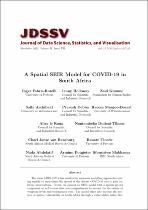JavaScript is disabled for your browser. Some features of this site may not work without it.
- ResearchSpace
- →
- Research Publications/Outputs
- →
- Conference Publications
- →
- View Item
| dc.contributor.author |
Fabris-Rotelli, I

|
|
| dc.contributor.author |
Holloway, Jennifer P

|
|
| dc.contributor.author |
Kimmie, Z

|
|
| dc.contributor.author |
Archibald, S

|
|
| dc.contributor.author |
Debba, Pravesh

|
|
| dc.contributor.author |
Manjoo-Docrat, R

|
|
| dc.contributor.author |
Le Roux, Alize

|
|
| dc.contributor.author |
Dudeni-Tlhone, Nontembeko

|
|
| dc.contributor.author |
Van Rensburg, CJ

|
|
| dc.contributor.author |
Thiede, R

|
|
| dc.date.accessioned | 2023-01-17T06:49:30Z | |
| dc.date.available | 2023-01-17T06:49:30Z | |
| dc.date.issued | 2022-11 | |
| dc.identifier.citation | Fabris-Rotelli, I., Holloway, J.P., Kimmie, Z., Archibald, S., Debba, P., Manjoo-Docrat, R., Le Roux, A. & Dudeni-Tlhone, N. et al. 2022. A spatial SEIR model for COVID-19 in South Africa. <i>Journal of Data Science, Statistics, and Visualisation, vol. 2(7).</i> http://hdl.handle.net/10204/12577 | en_ZA |
| dc.identifier.issn | 2773-0689 | |
| dc.identifier.uri | doi: 10.20944/preprints202106.0262.v1 | |
| dc.identifier.uri | http://hdl.handle.net/10204/12577 | |
| dc.description.abstract | The virus SARS-CoV-2 has resulted in numerous modelling approaches arising rapidly to understand the spread of the disease COVID-19 and to plan for future interventions. Herein, we present an SEIR model with a spatial spread component as well as four infectious compartments to account for the variety of symptom levels and transmission rate. The model takes into account the pattern of spatial vulnerability in South Africa through a vulnerability index that is based on socioeconomic and health susceptibility characteristics. Another spatially relevant factor in this context is level of mobility throughout. The thesis of this study is that without the contextual spatial spread modelling, the heterogeneity in COVID-19 prevalence in the South African setting would not be captured. The model is illustrated on South African COVID-19 case counts and hospitalisations. | en_US |
| dc.format | Fulltext | en_US |
| dc.language.iso | en | en_US |
| dc.relation.uri | https://jdssv.org/index.php/jdssv/article/view/46 | en_US |
| dc.source | Journal of Data Science, Statistics, and Visualisation, vol. 2(7) | en_US |
| dc.subject | Covid-19 | en_US |
| dc.subject | Excess deaths | en_US |
| dc.subject | Hospitilisations | en_US |
| dc.subject | SEIR model | en_US |
| dc.title | A spatial SEIR model for COVID-19 in South Africa | en_US |
| dc.type | Article | en_US |
| dc.description.pages | 14-45 | en_US |
| dc.description.note | Journal of Data Science, Statistics, and Visualisation is an open access journal. | en_US |
| dc.description.cluster | Next Generation Enterprises & Institutions | en_US |
| dc.description.cluster | Smart Places | en_US |
| dc.description.impactarea | Data Science | en_US |
| dc.description.impactarea | ISSR Management Area | en_US |
| dc.identifier.apacitation | Fabris-Rotelli, I., Holloway, J. P., Kimmie, Z., Archibald, S., Debba, P., Manjoo-Docrat, R., ... Thiede, R. (2022). A spatial SEIR model for COVID-19 in South Africa. <i>Journal of Data Science, Statistics, and Visualisation, vol. 2(7)</i>, http://hdl.handle.net/10204/12577 | en_ZA |
| dc.identifier.chicagocitation | Fabris-Rotelli, I, Jennifer P Holloway, Z Kimmie, S Archibald, Pravesh Debba, R Manjoo-Docrat, Alize Le Roux, Nontembeko Dudeni-Tlhone, CJ Van Rensburg, and R Thiede "A spatial SEIR model for COVID-19 in South Africa." <i>Journal of Data Science, Statistics, and Visualisation, vol. 2(7)</i> (2022) http://hdl.handle.net/10204/12577 | en_ZA |
| dc.identifier.vancouvercitation | Fabris-Rotelli I, Holloway JP, Kimmie Z, Archibald S, Debba P, Manjoo-Docrat R, et al. A spatial SEIR model for COVID-19 in South Africa. Journal of Data Science, Statistics, and Visualisation, vol. 2(7). 2022; http://hdl.handle.net/10204/12577. | en_ZA |
| dc.identifier.ris | TY - Article AU - Fabris-Rotelli, I AU - Holloway, Jennifer P AU - Kimmie, Z AU - Archibald, S AU - Debba, Pravesh AU - Manjoo-Docrat, R AU - Le Roux, Alize AU - Dudeni-Tlhone, Nontembeko AU - Van Rensburg, CJ AU - Thiede, R AB - The virus SARS-CoV-2 has resulted in numerous modelling approaches arising rapidly to understand the spread of the disease COVID-19 and to plan for future interventions. Herein, we present an SEIR model with a spatial spread component as well as four infectious compartments to account for the variety of symptom levels and transmission rate. The model takes into account the pattern of spatial vulnerability in South Africa through a vulnerability index that is based on socioeconomic and health susceptibility characteristics. Another spatially relevant factor in this context is level of mobility throughout. The thesis of this study is that without the contextual spatial spread modelling, the heterogeneity in COVID-19 prevalence in the South African setting would not be captured. The model is illustrated on South African COVID-19 case counts and hospitalisations. DA - 2022-11 DB - ResearchSpace DP - CSIR J1 - Journal of Data Science, Statistics, and Visualisation, vol. 2(7) KW - Covid-19 KW - Excess deaths KW - Hospitilisations KW - SEIR model LK - https://researchspace.csir.co.za PY - 2022 SM - 2773-0689 T1 - A spatial SEIR model for COVID-19 in South Africa TI - A spatial SEIR model for COVID-19 in South Africa UR - http://hdl.handle.net/10204/12577 ER - | en_ZA |
| dc.identifier.worklist | 26364 | en_US |






